The Independent's journalism is supported by our readers. When you purchase through links on our site, we may earn commission.
15 super healthy carb-load recipes perfect for the ultimate Marathon workout
From sweet potato gnocchi to harissa salmon quinoa and rhubarb and cherry porridge, Hannah Twiggs picks the best meals for energy and endurance – plus clever tweaks to make each dish marathon-ready without slowing you down

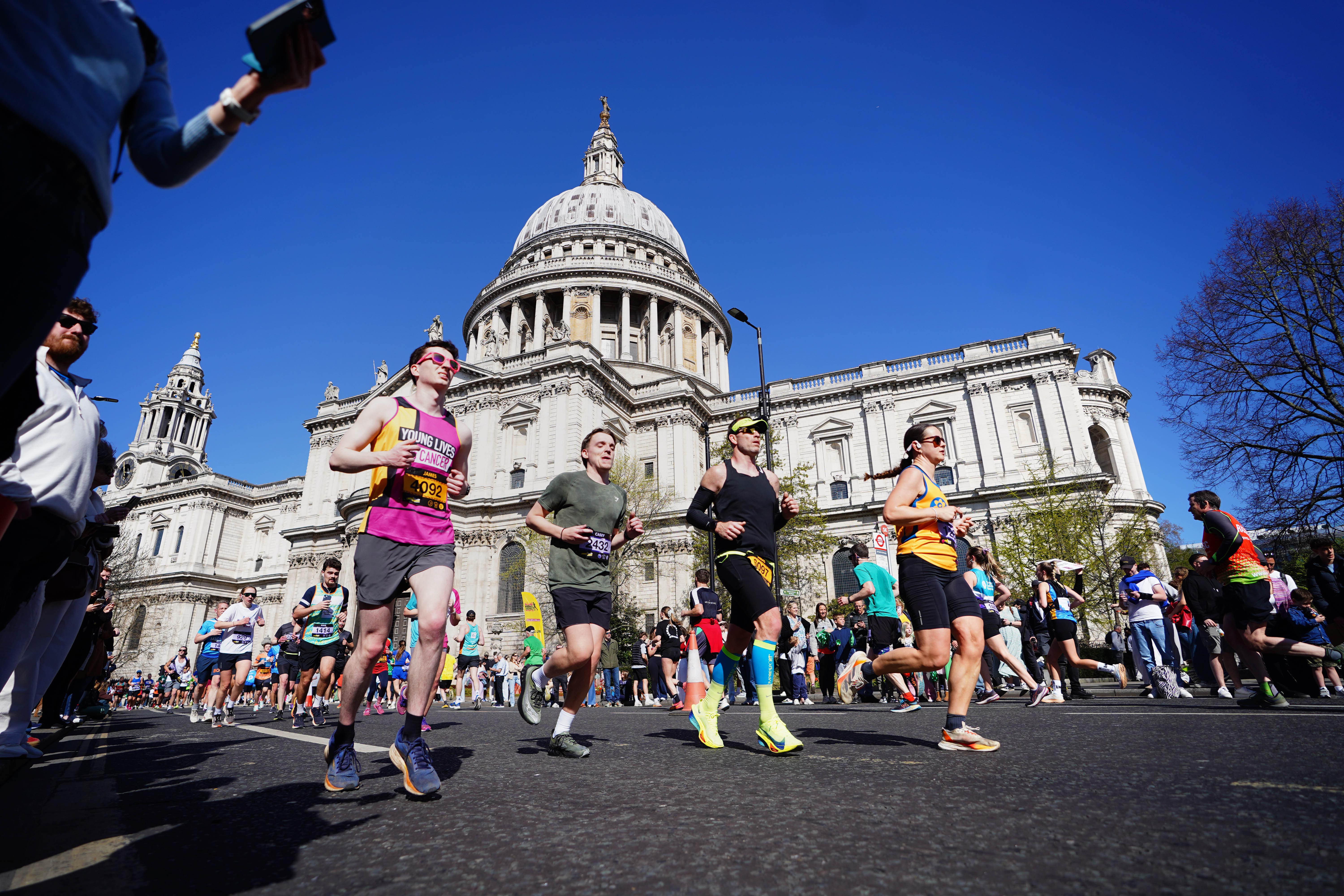
The London Marathon returns this Sunday 27 April, and whether you're chasing a personal best, just aiming to cross the finish line, what you eat in the days leading up to the race can make all the difference. According to guidance from London Marathon Events, runners should focus on meals rich in carbohydrates while keeping fibre, fat and protein relatively low to avoid stomach discomfort and optimise glycogen stores.
We've rounded up 15 healthy recipes built around those recommendations (you can read them in full here). All have been chosen for their digestibility and energy potential and are dishes guaranteed to fuel your stride.
Pasta recipes
Refined white pasta is one of the best sources of quick, accessible carbohydrates. It's low in fibre and fat, meaning it won't cause digestive distress in the lead-up to the race. It also absorbs simple sauces beautifully, making it an easy and versatile base for a pre-race meal.
Sweet potato gnocchi with borlotti beans and Marmite
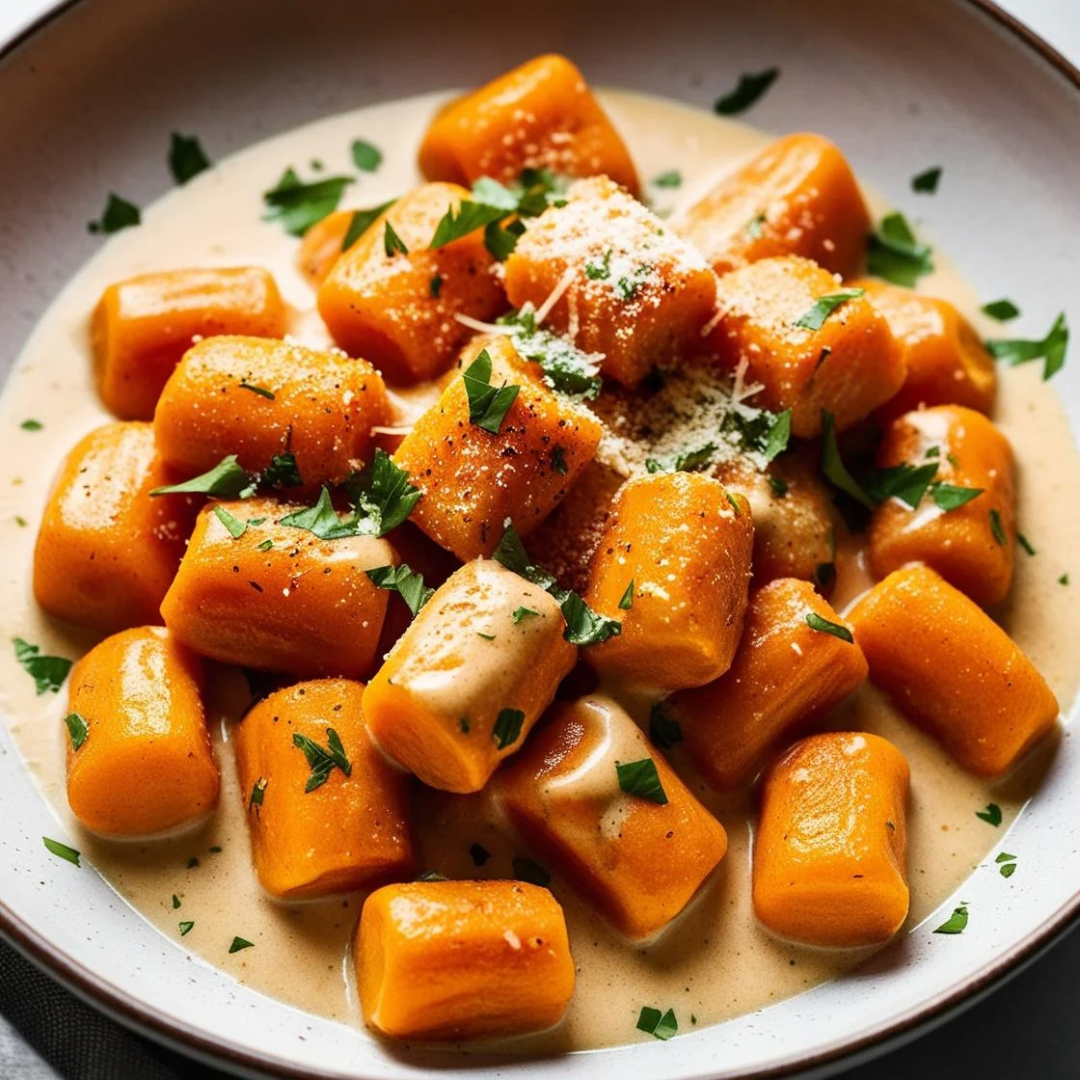
This dish combines slow-burning carbs from roasted sweet potato with starchy flour for a homemade gnocchi that's light, soft and energy-rich. Borlotti beans offer additional protein and fibre, while Marmite contributes a B12 boost and salty, umami depth. It’s comforting, nourishing and a little bit unexpected – ideal marathon fuel.
Marathon-friendly adjustment: Reduce the borlotti beans to lower fibre content, and skip the parmesan to reduce fat. Swap for a simple tomato or olive oil-based sauce, and serve with a slice of white bread or plain pasta on the side for an added carb boost.
Recipe by: Nima Safaei, London chef and restaurateur
Serves: 4
Ingredients:
For the gnocchi:
500g sweet potatoes (about 2 medium), roasted and mashed
150g plain flour (plus extra for dusting)
1 egg yolk
1 tsp Marmite
Salt and pepper to taste
For the sauce:
2 tbsp olive oil
2 cloves garlic, finely chopped
1 small red onion, diced
1 tsp rosemary or thyme (fresh or dried)
1 x 400g tin borlotti beans, drained and rinsed
200ml vegetable stock
1 tbsp tomato paste
1 tsp Marmite (optional, for extra depth)
Salt, pepper and chilli flakes to taste
Fresh parsley, chopped
Parmesan
Olive oil drizzle
Method:
- Let’s begin with the sweet potatoes! Preheat the oven to 200C (180C fan), then pierce the sweet potatoes and roast whole for 40 minutes until soft. Scoop out flesh, mash and allow to cool.
- Now let’s make the gnocchi dough. In a bowl, mix the mashed sweet potato with flour, egg yolk, Marmite, salt and pepper. Bring together into a soft, slightly sticky dough and try to avoid overworking it.
- Lightly flour your surface to prepare for shaping the gnocchi. Divide dough into 4 pieces, roll each into a rope around 2cm thick, and cut into bite-sized pillows. Press gently with a fork if you want the classic ridges.
- Bring a large pot of salted water to a simmer. Drop in the gnocchi in batches. When they float to the top, they’re done (you’re looking at around 2-3 minutes). Once done, scoop out and set aside.
- In a pan, heat olive oil over medium heat, then sauté garlic, onion, and herbs until soft. Stir in borlotti beans, tomato paste, stock, and the secret ingredient – Marmite! Simmer for 10-15 minutes until rich and thick. Season to taste.
- Toss the cooked gnocchi gently in the sauce. Heat together for 2-3 minutes – this ensures the gnocchi soaks up the flavour.
- Plate up – I like to finish with a drizzle of olive oil, sprinkle of parsley, and a generous shave of Parmesan!
Midsummer pasta
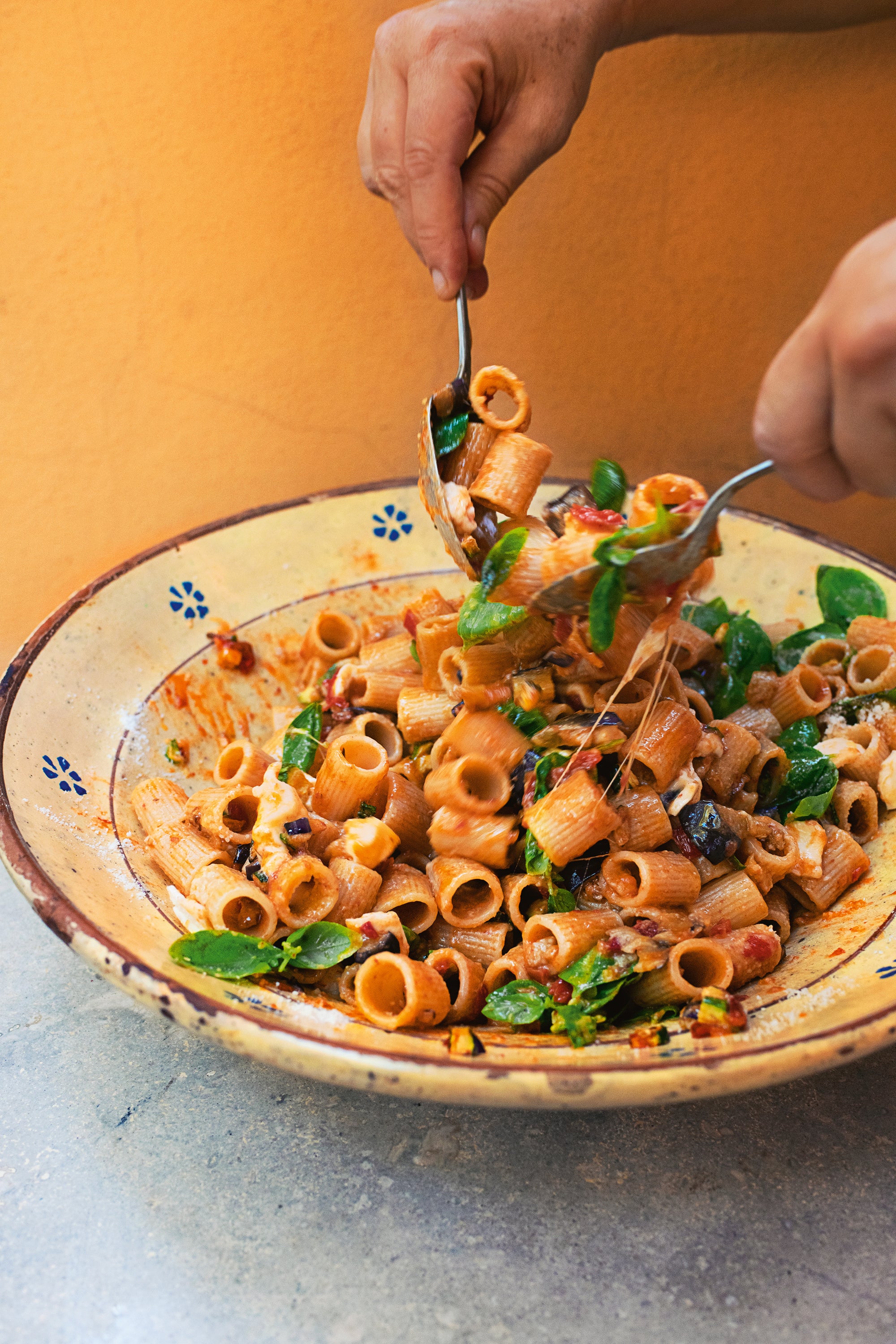
Packed with classic Mediterranean vegetables and tossed through white pasta, this dish offers a generous serving of carbohydrates with added flavour from mozzarella, parmesan and fresh herbs. It's hearty without being heavy, and the vegetables are cooked until soft, making them easier on the gut.
Marathon-friendly adjustment: Lighten the dairy by reducing or removing the mozzarella and parmesan, and swap in extra pasta or soft-cooked vegetables like courgette or aubergine to keep energy high and digestion light.
Recipe by: Rachel Roddy
Serves: 6
Ingredients:
Olive or vegetable oil, for frying
1 large aubergine, diced into 1cm cubes
1 red pepper, diced into 1cm cubes
2 courgettes, diced into 1cm cubes
Salt
2 large ripe tomatoes
1 clove of garlic, peeled and crushed
600g mezze maniche, penne, fusilli or rigatoni
100g parmesan, grated
200g mozzarella, diced
A big sprig of fresh basil leaves, ripped
Method:
- Bring a large pan of water to the boil for the pasta.
- Pour enough oil into a deep, medium-sized frying pan for it to come 2.5cm up the sides and heat until hot. Working in batches, fry the diced vegetables in the oil until soft and golden, then blot on a kitchen towel, season with salt and keep warm. Tip the oil from the pan.
- Plunge the tomatoes into the almost boiling water for a minute, then lift them out with a slotted spoon and refresh under cold water, at which point the skins should slip off. Roughly chop the tomatoes.
- Put the frying pan back on the heat with 4 tbsps of new oil and the garlic. Once the garlic is fragrant, add the chopped tomatoes and a pinch of salt and cook until soft and saucey – about 10 minutes.
- Once the water is boiling, add salt, stir, then add the pasta and cook until al dente. Once the pasta is ready, drain, tip into the tomato pan and toss.
- Tip the pasta and sauce into a large bowl, add the fried vegetables, parmesan, mozzarella and ripped basil, toss thoroughly and serve.
Butternut squash gnocchi

This quick and budget-friendly gnocchi uses roasted root veg (squash, carrot, parsnip) mashed with plain flour to form soft, chewy dumplings. It’s naturally high in carbohydrates and gentle on the stomach. Topped with peanuts, sage and parmesan, it’s a well-rounded, energy-dense meal.
Marathon-friendly adjustment: Omit peanuts and reduce parmesan to lower fat content. Add a side of white bread or plain pasta for extra carbs, and stick with roasted or boiled vegetables over raw.
Recipe by: Miguel Barclay
Serves: 1
Time: 1 hour
Ingredients:
¼ butternut squash, cut into chunks
1 large carrot, cut into chunks
1 large parsnip, cut into chunks
3-4 tbsp of plain flour (plus extra for dusting)
25g of plain unsalted peanuts
1 tbsp of grated parmesan
Handful of sage leaves
3 tsp of olive oil
Salt and pepper
Method:
- Drizzle 2 tsp of olive oil onto the squash, carrot and parsnip chunks and season with salt and pepper. Roast in the oven on a tray for about 20 minutes at 200C, until soft but not charred.
- Mash with a fork and then mix in 3 tbsp of plain flour (add more flour if needed) and gently knead on a floured work surface to create a dough.
- Roll into a sausage, and chop into 2cm pieces.
- Pan fry over a high heat along with the peanuts and sage in a tsp of olive oil, then serve with grated parmesan.
Porridge recipes
Oats are an excellent source of carbohydrates and provide steady energy release. When cooked with milk or water, they’re low in fibre and fat and very easy to digest – making them one of the best pre-race breakfasts available.
Rhubarb and cherry porridge
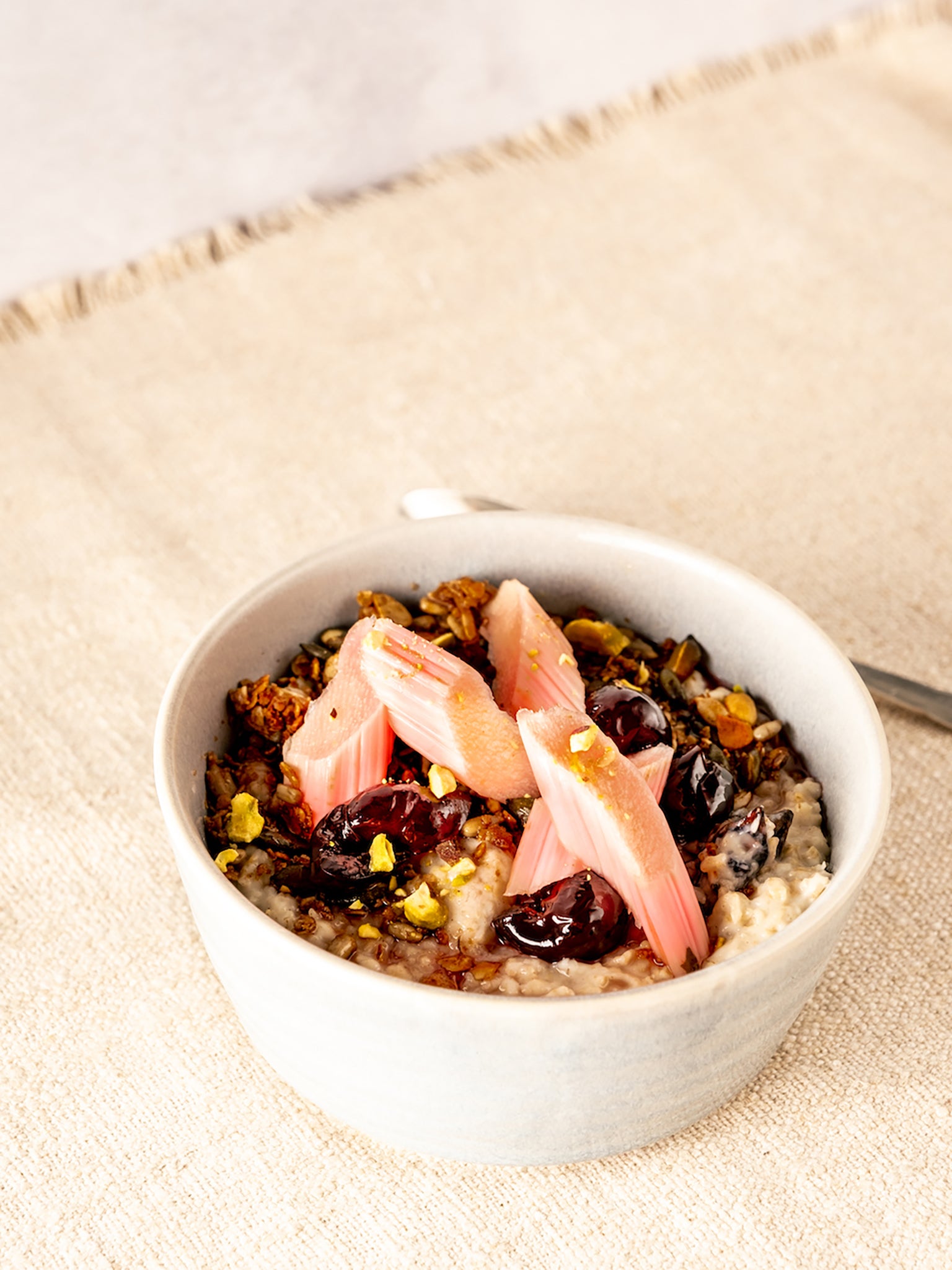
This fragrant porridge is made with oats, milk and warming spices, then topped with gently poached rhubarb and sweet cherry preserves. It delivers slow-release energy with minimal fat, while the fruity topping adds a touch of natural sugar to keep your glycogen stores topped up.
Marathon-friendly adjustment: Consider stirring in a tsp of honey or jam for added simple carbs, and use low-fat milk for balance.
Recipe by:Tasos Gaitanos and Alex Large
Serves: 4
Ingredients:
For the porridge:
200g oats
500ml whole milk
1 star anise
Pinch of ground cinnamon
Pinch of ground nutmeg
For the rhubarb:
300g forced rhubarb
120g caster sugar
1 sprig of rosemary
Juice of a ¼ lemon
To serve:
4 tbsp maple granola
4 tbsp sweet preserves
4 tsp finely chopped pistachios
Method:
- Place the oats in a pan with the milk, star anise, cinnamon, nutmeg and 500ml water and stir while slowly bringing the mixture to a boil. Stirring is the key to getting the perfect porridge consistency! Simmer for 5 minutes, stirring all the time, then take off the heat once it is thick. If you need to loosen it further just add a splash of water.
- Wash the rhubarb and trim the ends off, then slice it diagonally every 2cm to make diamond shapes. Bring a pan of water to the boil and drop the rhubarb into it, boil for a couple of minutes, until just tender, and drain. Place the blanched rhubarb back in the pan and add the sugar, rosemary, lemon juice and 230ml water. Bring to the boil and immediately take off the heat and cover – the idea here is to keep the rhubarb nice and firm while also dissolving the sugar in rhubarby juices.
- To serve, divide the warm porridge between four bowls and top each with a tbsp of the granola and a tbsp of the cherry spoon sweets and their syrup. Arrange some rhubarb pieces on top and pour over some of the juices, then scatter over some finely chopped pistachios.
Overnight protein porridge with cinnamon, turmeric and cacao

This recipe combines oats with hemp seeds, nuts, cacao and spices to deliver a nutrient-rich, filling breakfast. While it’s designed to support recovery and long-term health, it can be tweaked for marathon fuelling.
Marathon-friendly adjustment: Focus on oats and milk only; reduce seeds, nuts and yoghurt. Consider adding a mashed banana or a spoonful of fruit compote for flavour and quick-release carbs.
Recipe by: Dr Rupy Aujla
Serves: 1
Ingredients:
30g shelled hemp seeds
20g jumbo rolled oats
20g cacao powder
½ tsp ground cinnamon
¼ tsp ground turmeric
15g flaked almonds
15g walnuts, crumbled
10g desiccated coconut
100ml whole milk or plant-based alternative
2 prunes, roughly chopped
To serve:
80g mixed berries
20g pumpkin seeds or nut butter of choice
1 tbsp thick natural yoghurt
Method:
- Add all the dry ingredients together to a large glass jar. Screw the lid on and shake vigorously to mix all the components together.
- Remove the lid and stir in the milk, 50ml water and the prunes. Replace the lid and place in the fridge overnight.
- In the morning, add a splash more milk if needed, and serve topped with the berries, pumpkin seeds or nut butter and yoghurt.
Protein boost: Add more cacao powder; pumpkin seeds or nut butter. You can also use an unflavoured protein powder.
Sweet potato recipes
Sweet potatoes are a fantastic source of complex carbohydrates and are naturally lower in fibre when peeled. They provide a slow, steady release of energy and are rich in potassium – helpful for maintaining electrolyte balance.
Sweet potato nachos
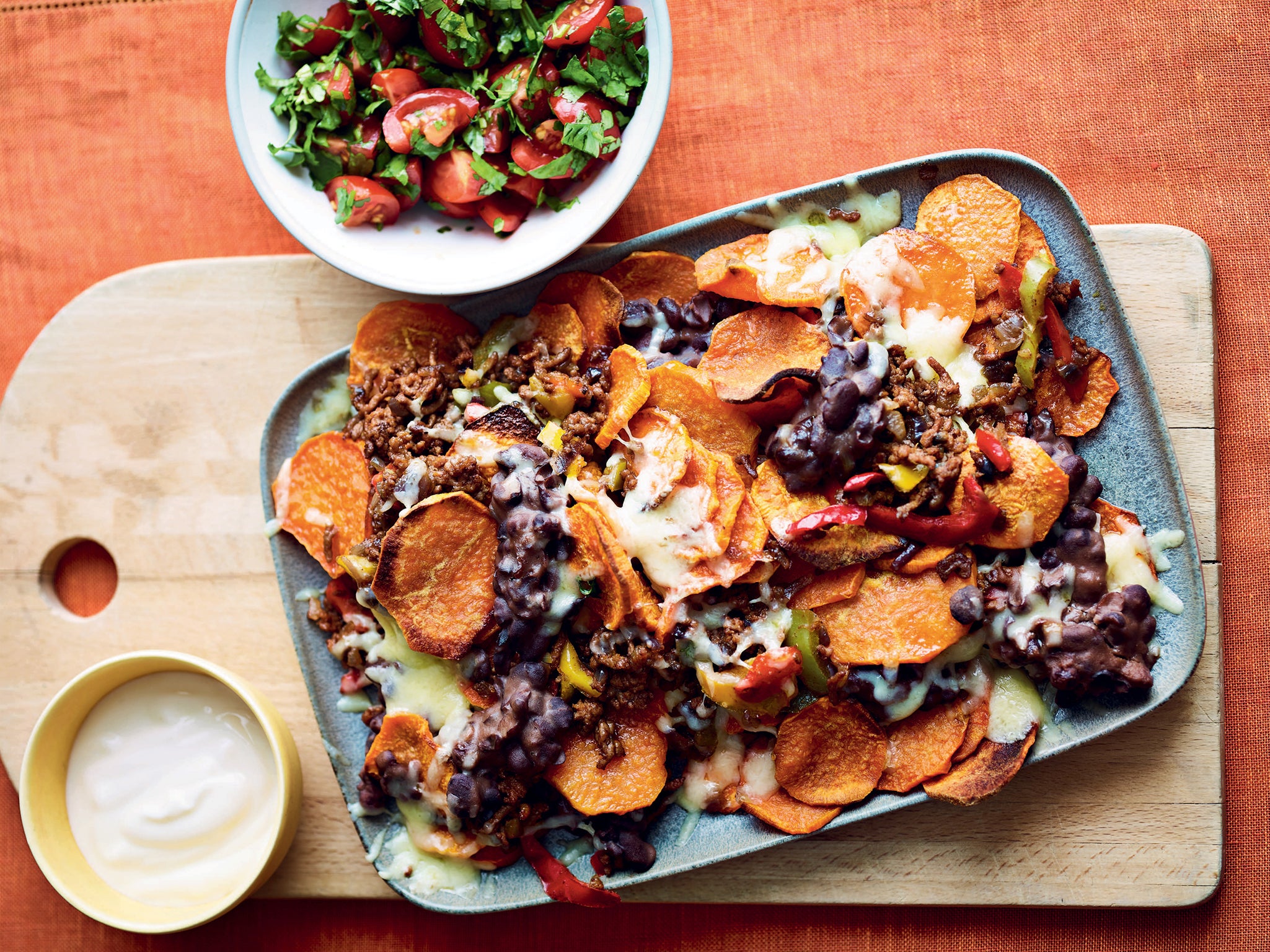
Thinly sliced and roasted sweet potatoes replace corn chips in this hearty traybake, topped with veggie mince, refried beans, cheese and yoghurt. While originally designed as a high-protein meal, it’s easily adapted for carb loading.
Marathon-friendly adjustment: Reduce or omit beans and cheese, and use a small amount of yoghurt. Add a slice of white toast or a plain tortilla to increase carb count.
Recipe by: Joe Wicks
Serves: 4
Ingredients:
4 medium sweet potatoes (around 600g), peeled and sliced into 5mm thick coins
1 tbsp light olive oil
1 tsp salt
60g cheddar cheese, grated
4 tbsp low-fat natural yoghurt, to serve
For the spiced mince:
1 tbsp oil
1 red onion, diced
100g veggie mince (or minced beef)
½ tsp ground cumin
½ tsp ground coriander
½ tsp smoked paprika
Pinch of chilli powder
130g frozen sliced bell pepper (or the same amount of fresh, sliced)
For the refried beans:
400g tin of black beans, drained but liquid reserved
Pinch of salt
1 tsp ground cumin
For the salsa:
200g cherry tomatoes, roughly chopped
Big handful of fresh coriander, finely chopped
Juice of 1 lime
Pinch of salt
Method:
- Preheat the oven to 200C/180C fan.
- Toss the sliced sweet potatoes with the oil and salt on a large baking tray, then spread them out into a single layer (you may need a second baking tray). Roast for 30-40 minutes, flipping them over halfway through, until starting to turn golden.
- For the spiced mince, heat the oil in a large frying pan over a medium-low heat. Add the onion and cook for about five minutes until translucent. Add the mince, breaking it up with your spoon, and cook for a few minutes according to the packet instructions, or until the mince is no longer pink if using beef. Stir in the cumin, coriander, paprika, chilli powder and frozen (or fresh) sliced peppers. Stir until the peppers have defrosted and warmed through (about five minutes if using fresh, until softened). Tip into a bowl and set aside.
- For the refried beans, return the same pan to the heat and add the drained beans along with 100ml of the liquid reserved from the tin, the salt and cumin. Mash with a potato masher in the pan, loosening with more bean liquid as needed, to make a creamy, slightly chunky paste. Remove from the heat and set aside.
- Mix together all of the salsa ingredients in a small bowl and set aside.
- Once the potato nachos are roasted, top with spoonfuls of the refried beans, followed by a layer of the mince mixture and finally sprinkle over the grated cheese.
- Return to the oven for 10-15 minutes until the cheese has melted and crisped up in places.
- Remove from the oven, top with the salsa and some dollops of yoghurt, then serve.
Sweet potato, cauliflower and peanut curry
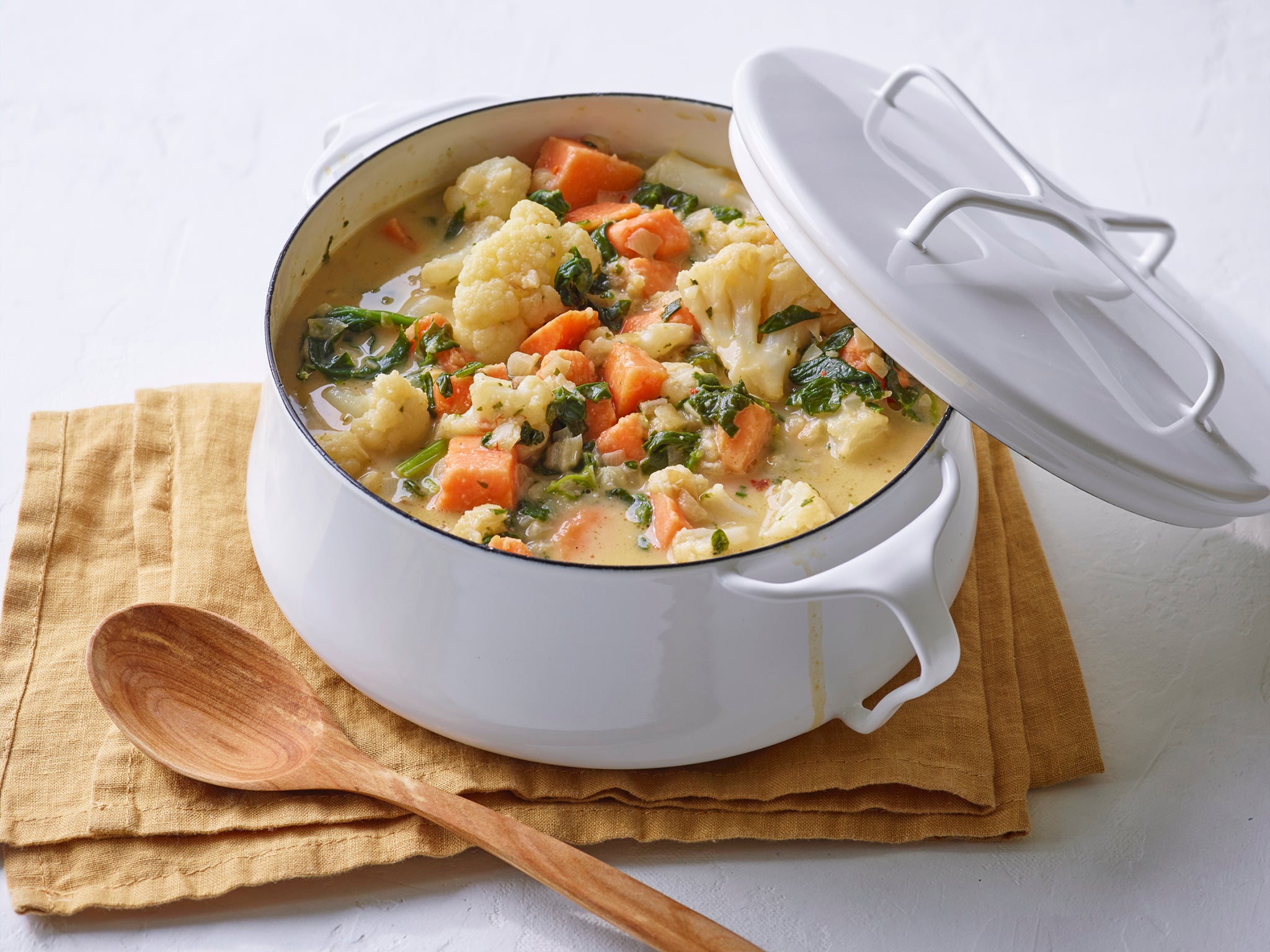
This warming curry is built on a base of sweet potato and rice, with added creaminess from coconut milk and peanut butter. It's fibre-rich thanks to the cauliflower and spinach, and high in flavour.
Marathon-friendly adjustment: Serve with white basmati rice instead of wholegrain. Reduce peanut butter to limit fat and omit spinach if needed to reduce fibre. Include a banana or white bread roll on the side to round out the carbs.
Recipe by: Phil Vickery
Serves: 4
Ingredients:
4 tbsp any oil
250g frozen chopped onions
1 tbsp dried garlic granules
½ tsp dried chilli flakes
2 tbsp frozen chopped ginger
400g can coconut milk
2 heaped tbsp peanut butter
10g vegetable stock cube, crumbled
500g frozen cubed sweet potato
500g frozen cauliflower florets
1-2 tbsp cornflour
300g (about 6 × 50g balls) frozen spinach
1-2 tsp sugar
Salt and freshly ground black pepper
2 × 250g packets microwaveable basmati rice, warmed, to serve
Method:
- Heat the oil in a pan over a high heat and then add the onions, garlic granules, chilli flakes and ginger. Cook for six to eight minutes to drive off the moisture and colour a little.
- Add the coconut milk, half-fill the can with water, then add to the pan along with the peanut butter and stock cube and whisk. Bring to a simmer, then cook for five minutes.
- Add the frozen sweet potato and cauliflower and bring back to a simmer for 10 minutes.
- Mix the cornflour well with 2 tbsps of cold water and then add to the simmering curry: it will thicken pretty much straight away.
- Check the seasoning and adjust if needed, then drop in the frozen spinach. Cover and simmer for five minutes, then stir in the sugar, turn off the heat and leave for 15 minutes.
- Stir well and serve with the basmati rice.
Salmon recipes
Salmon is an excellent source of protein and omega-3 fatty acids, which are useful for muscle recovery and reducing inflammation. It’s better suited to meals 24-48 hours before the race rather than the night before, as it contains more fat and protein than ideal for pre-race day.
Harissa salmon, herb dressing and veggie quinoa
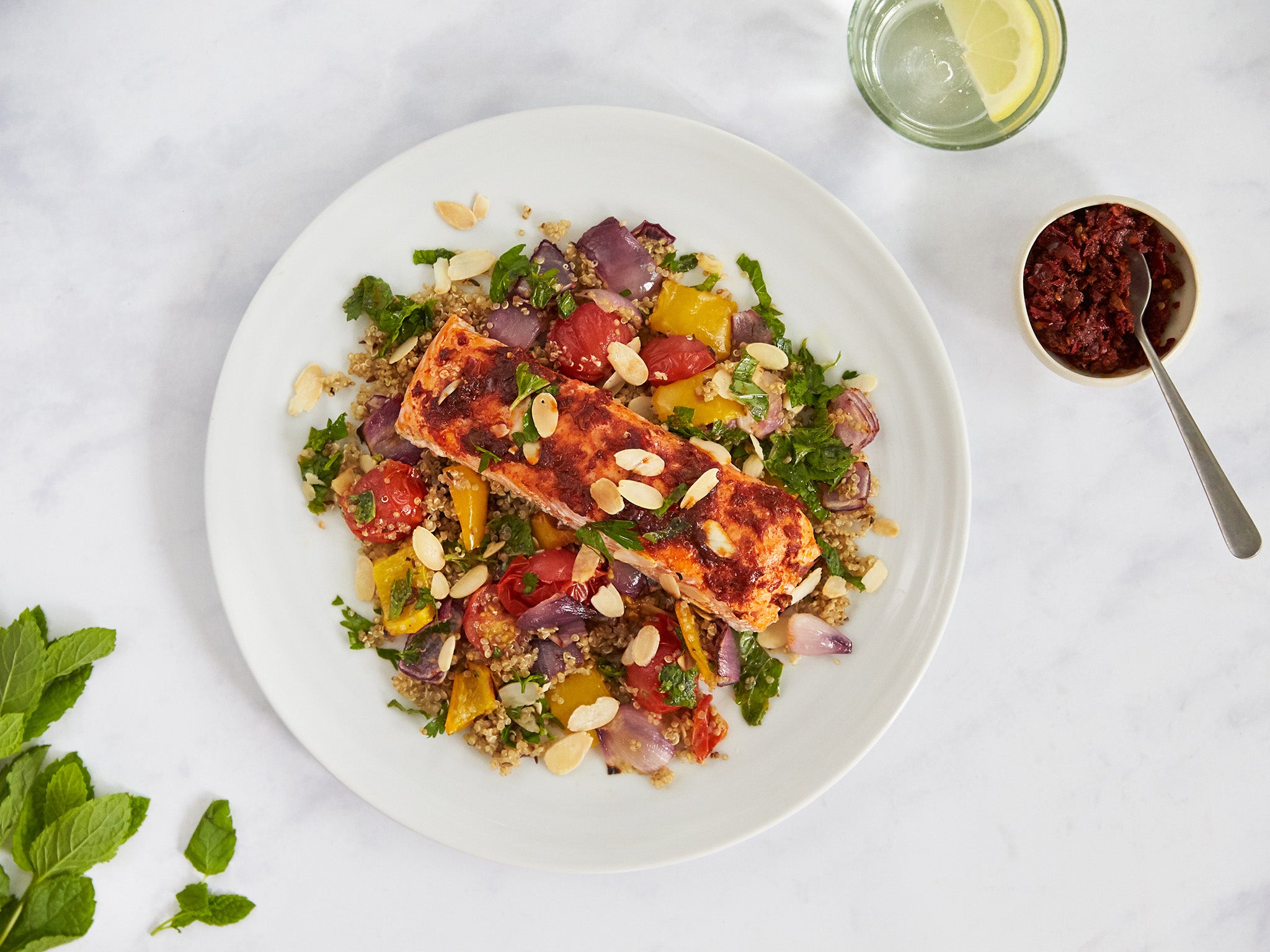
This dish features roasted vegetables and quinoa with herby salmon on top. It’s nutritionally balanced, but quinoa and vegetables contribute a modest carb content compared to white pasta or rice.
Marathon-friendly adjustment: Reduce salmon portion slightly and increase the serving of quinoa. Add a side of white rice or couscous for more low-fibre carbs. Keep the dressing light and avoid raw herbs if your stomach is sensitive.
Recipe by: Mindful Chef
Ingredients:
10g flaked almonds
120g cherry tomatoes
½ lemon
1 red onion
1 yellow pepper
2 tbsp oil
2 tsp cumin seeds
2 tsp harissa paste
2 x 150g salmon fillet (skin on)
80g quinoa
Medium handful of flat-leaf parsley
Medium handful of fresh mint
Method:
- Preheat the oven to 180C and boil a kettle. Cut the red onion and yellow pepper into bite-sized pieces and place on a baking tray, drizzle with 1 tbsp olive oil and sprinkle over the cumin seeds and a pinch of sea salt. Place in the oven for 20-25 minutes.
- Meanwhile, heat a dry saucepan on a medium-high heat and add the flaked almonds for 2-3 minutes until turning golden. Remove from the pan and set aside.
- Rinse the quinoa and place into the same saucepan with 300ml boiling water and a pinch of sea salt. Simmer for 15 minutes, then drain.
- Spread the harissa paste on the salmon fillets and sprinkle over a pinch of sea salt. Place on a baking tray with the whole cherry tomatoes and place in the oven for 10-15 minutes until the fish is cooked through.
- Meanwhile, to make a herby dressing; finely chop the fresh parsley and mint leaves. In a small bowl, mix the fresh herbs with the juice from the half lemon and 1 tbsp olive oil.
- Mix the roasted onion, yellow pepper and cherry tomatoes with the cooked quinoa. Season with sea salt and black pepper to taste.
- Serve the roasted vegetable quinoa on two warm plates and top with the harissa salmon. Drizzle over the herby dressing and scatter over the flaked almonds.
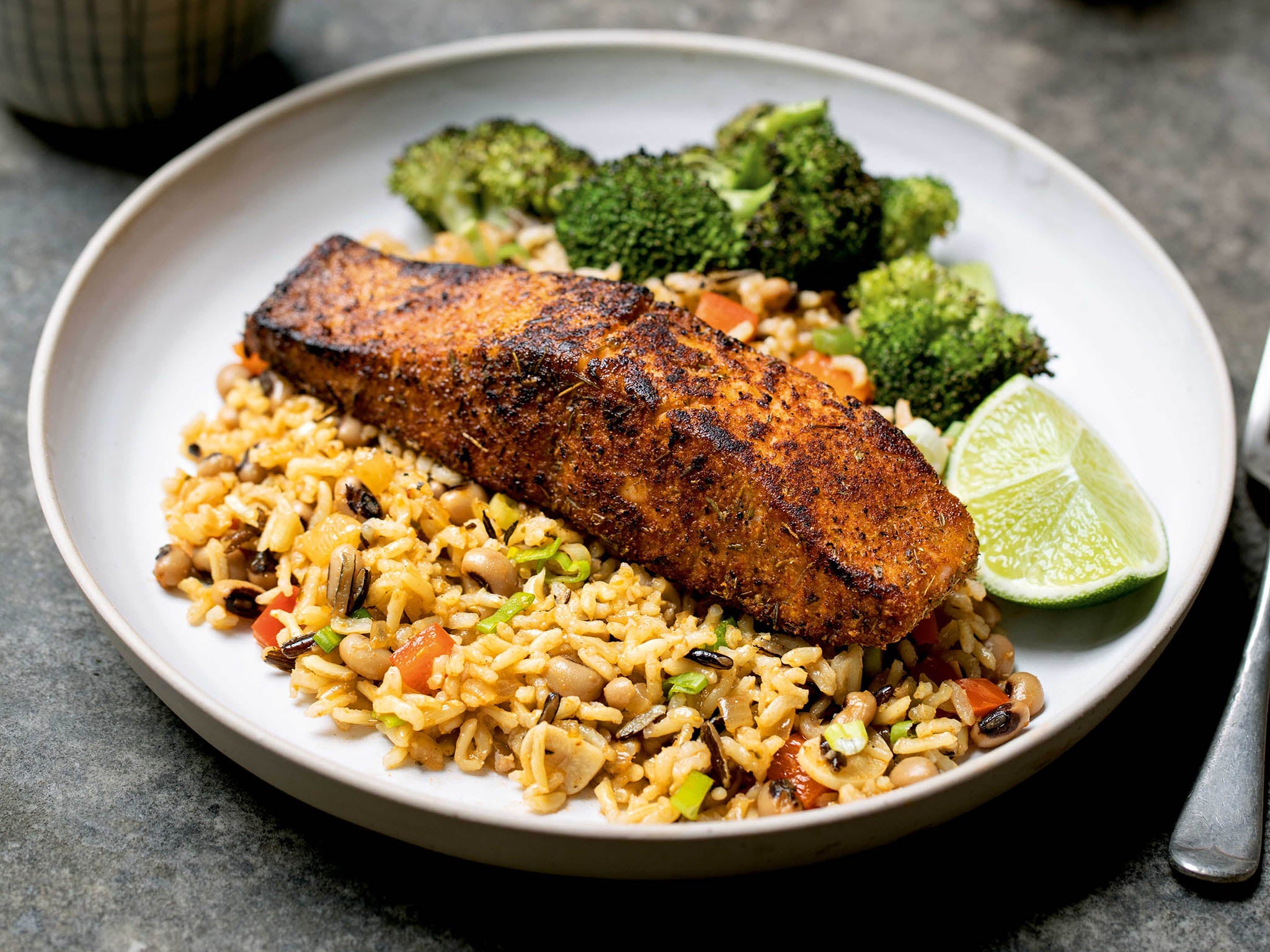
This New Orleans-inspired recipe brings together Cajun-spiced salmon with a generous serving of rice, beans and vegetables for a dish that delivers big flavour and sustained energy. The rice forms a strong carbohydrate base, while the salmon supports recovery.
Marathon-friendly adjustment: Swap brown and wild rice for white, reduce beans slightly and serve with plain white bread or mashed potatoes to increase carb density without adding fibre.
Recipe by: Tom Kerridge
Serves: 4
4 skinless salmon fillets (120g each)250g (1 small head) broccoli
1-cal sunflower oil spraySea salt and freshly ground black pepper
For the Cajun seasoning:
1 heaped tsp ground cumin1 tsp garlic granules½ tsp hot smoked paprika½ tsp cayenne pepper½ tsp dried oregano½ tsp dried thyme
For the dirty rice:
1 tsp olive oil1 onion, finely diced2 garlic cloves, sliced1 red pepper, cored, deseeded and finely diced1 tbsp tomato puree1 tsp dried oregano½ tsp dried thyme200ml fresh chicken stock400g tin black eye beans500g cooked brown and wild rice (freshly cooked and drained or 2 pouches)
4 spring onions, finely sliced
To serve:
1 lime, cut into wedges
Method:
- Preheat the oven to 200C/fan 180C/gas 6.
- For the Cajun seasoning, mix the ingredients together in a small bowl with 1 tsp flaky sea salt. Pat each salmon fillet dry with kitchen paper and then sprinkle with the seasoning on all sides. Leave to marinate while you prepare the broccoli and dirty rice.
- Line a baking tray with a silicone mat (or spray with oil). Cut the broccoli into bite-sized florets, season with salt and pepper and spread out on the tray. Cook on a high shelf in the oven for 12 minutes or until the broccoli is lightly charred and cooked through.
- Meanwhile, for the dirty rice, heat the oil in a large sauté pan over a medium heat. When hot, add the onion and cook for 4-5 minutes until softened. Add the garlic and cook for 2 minutes, then add the red pepper and tomato purée and stir well. Add the oregano, thyme and stock and bring to a simmer.
- Drain the black eye beans and add to the pan with the rice. Cook for another 5 minutes. Season well with salt and pepper and stir through the spring onions.
- Heat a medium non-stick frying pan over a medium heat. Spray the salmon fillets a few times with oil then place in the pan. Cook for 2-3 minutes on each side or until lightly charred and cooked through.
- Spoon the rice into 4 shallow bowls or containers and add the broccoli and salmon. Serve at once, with lime wedges. Or cool then seal and keep in the fridge. Eat within 2 days, either cold or reheated.
Spinach recipes
Spinach is rich in iron, which is essential for energy metabolism and oxygen transport. When cooked, it’s much lower in fibre than raw, making it a good addition to carb-based meals in moderation.
Creamy spinach and potato bake
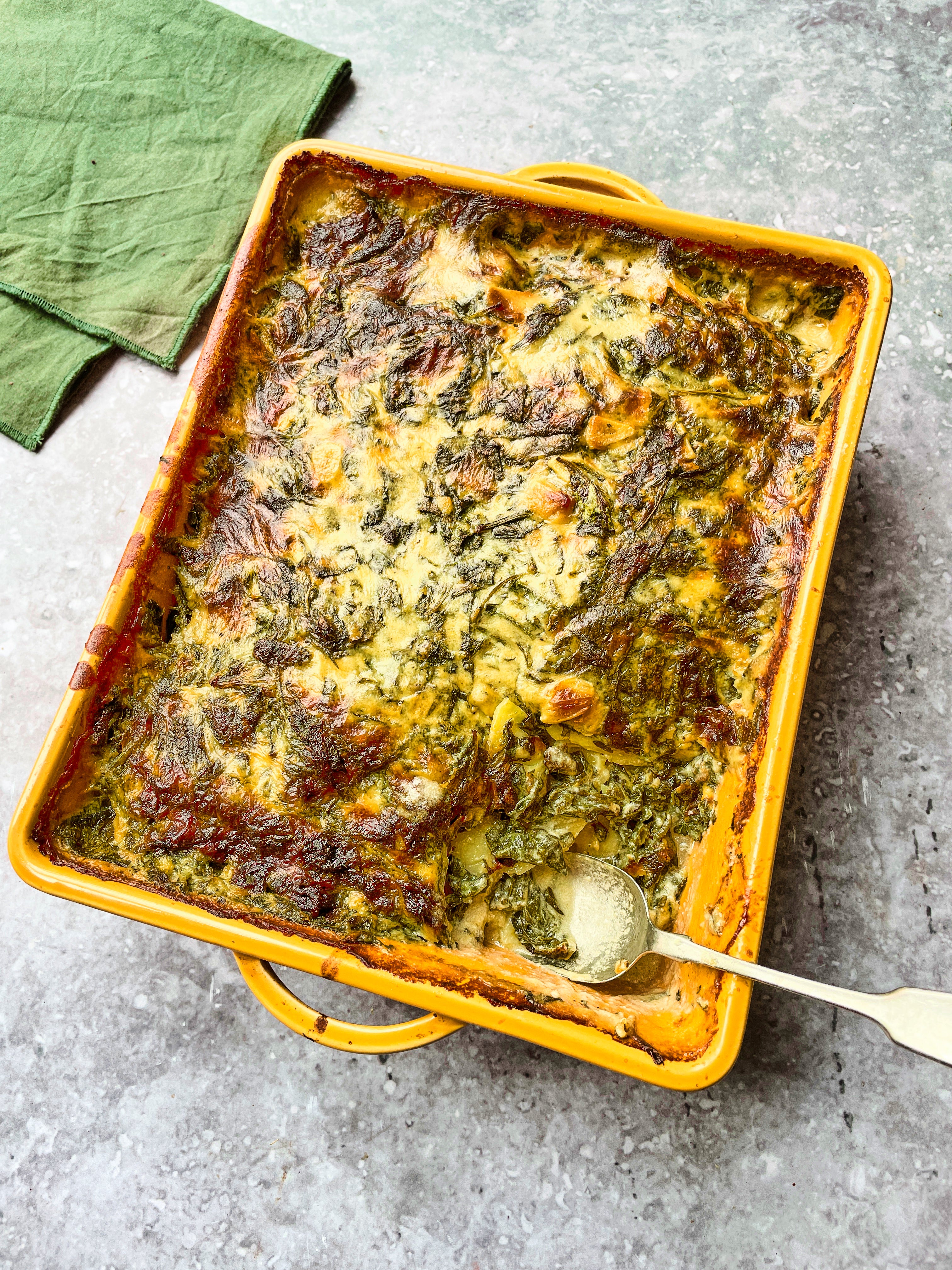
This layered bake brings together floury potatoes, cooked spinach, and a cheesy, creamy sauce. It’s warming, indulgent and ideal when eaten in small portions alongside a lean protein.
Marathon-friendly adjustment: Halve the cheese and creme fraiche to reduce fat. Increase the amount of potato and pair with a slice of white bread or a small portion of white rice to build glycogen stores.
Recipe by: Discover Great Veg
Serves: 8
Ingredients:
1.5kg floury potatoes, peeled and finely sliced
1½ tbsp butter
3 garlic cloves, sliced
3 tbsp plain flour
400ml milk
300ml vegetable stock
1 tbsp white miso
2 tbsp fresh thyme
200ml reduced fat creme fraiche
Pinch of nutmeg
260g bag of spinach
70g reduced-fat cheddar cheese, grated
Method:
- Preheat your oven to 180C/gas mark 4.
- Layer the potatoes in a medium high-sided baking/casserole dish (28 x 22cm dish).
- In a large frying pan, fry the garlic in the butter for 1-2 minutes, then stir in the flour.
- Slowly add the milk and stock, stirring continuously until it forms a smooth and thick sauce.
- Now add the miso, thyme, crème fraiche, nutmeg, spinach and grated cheese. Stir to combine and simmer for a further minute or so until the cheese is melted, and the spinach wilted. Season to taste.
- Pour the mixture over the top of the potatoes, making sure all the layers of potatoes are submerged in the liquid.
- Bake, uncovered, for 1 hr or until tender when pierced through the middle with a knife, and the top is golden and bubbling.
Cooking tip: You can swap the spinach for cavolo nero. Great on its own or with some protein on the side (fish, chicken, etc).
Sweetcorn and spinach dhal
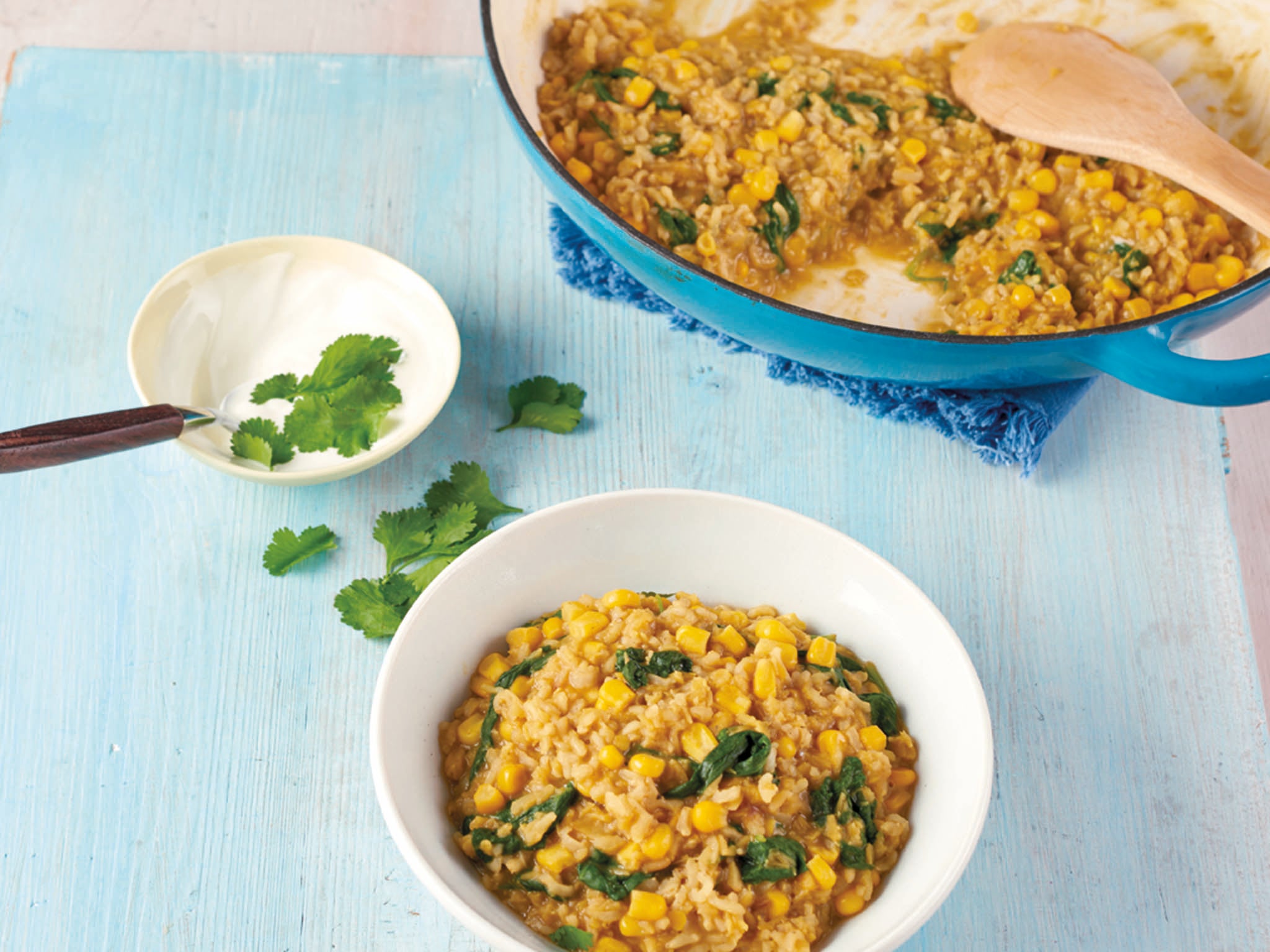
This dhal blends lentils, rice, sweetcorn and spinach into a bowl full of flavour and long-lasting energy. While the lentils and brown rice provide a hearty base, they can be adjusted for easier digestion.
Marathon-friendly adjustment: Swap brown rice for white and reduce lentils slightly. Serve with pitta or naan (opt for white flour versions) to add digestible carbs without upping fibre.
Recipe by: Lizzie King
Serves: 4
Ingredients:
2 tbsp rapeseed oil
1 onion, finely sliced
2 garlic cloves, minced
½ tsp turmeric
1 tsp ground coriander
180g brown basmati rice (or use white rice and halve the cooking time
1 litre vegetable or chicken stock
180g dried red lentils
225g frozen spinach
150g frozen sweetcorn kernels
225g frozen spinach
To serve:
Coconut yoghurt
Lime wedges
Coriander leaves
Method:
- In a large casserole dish or heavy-based pan, heat the rapeseed oil and add the onion, garlic and spices. Stir occasionally for about 3-4 minutes until softened but not browned. Add the rice and stir through to coat in the oil and spices. Pour over 500ml of the stock and bring to the boil over a high heat. Reduce the heat to low and simmer, covered, for 30 minutes. Glance in occasionally to check the rice isn’t sticking to the bottom of the pan.
- Add the lentils, and a little more stock if needed. Cover and continue to simmer gently until the rice and lentils are softened, about 20 minutes. Add more stock now and again if needed. Stir in the sweetcorn and spinach and allow to cook over a low heat for a few minutes until piping hot.
- Serve with a dollop of yoghurt, a squeeze of lime and a scattering of coriander leaves.
Grapefruit recipes
Grapefruit is hydrating and rich in vitamin C, which supports the immune system and helps fight inflammation. Its sharpness also refreshes the palate, especially when appetite is reduced during taper week.
Salmon salad with pink grapefruit
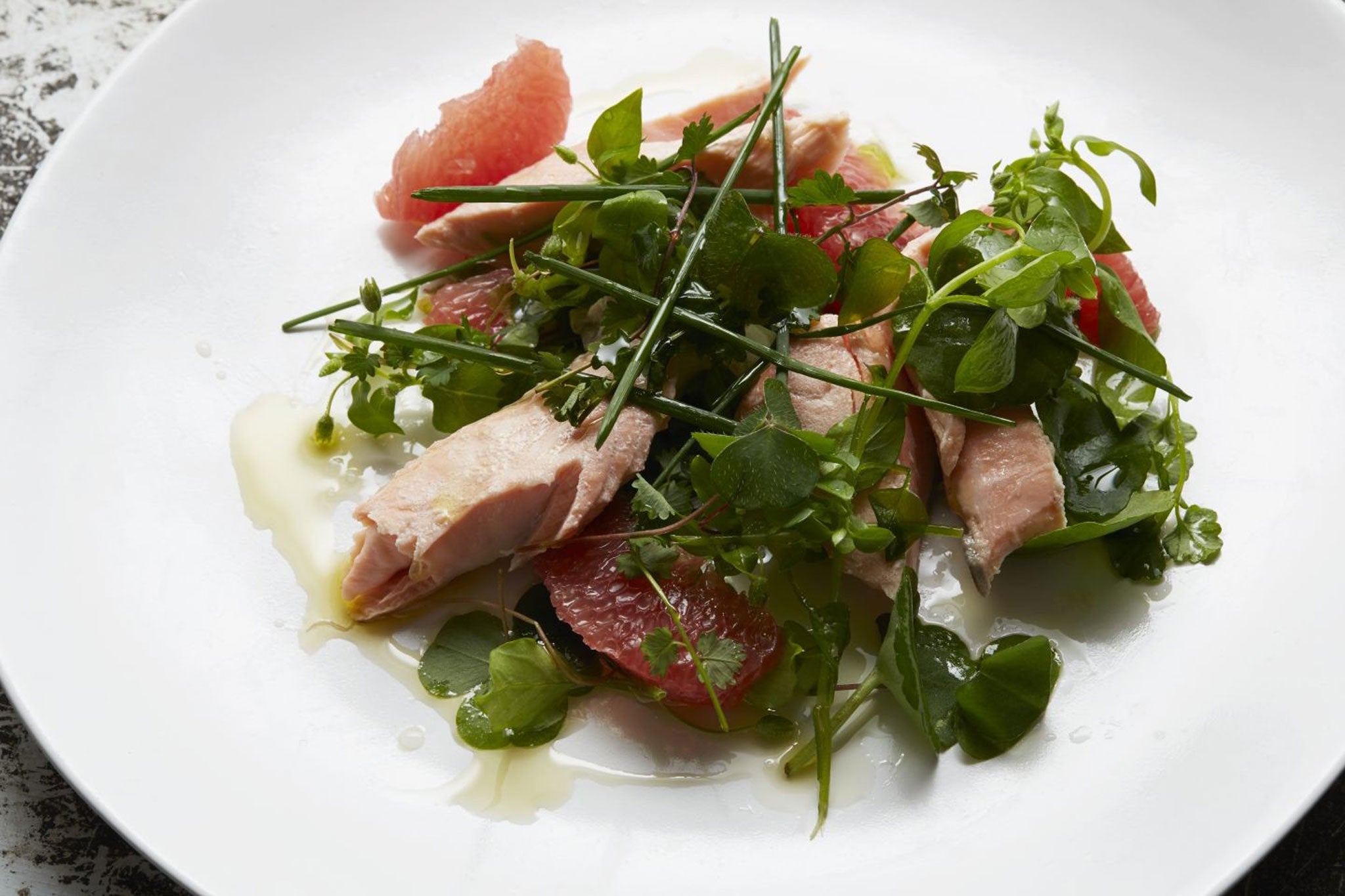
This salad features delicate flakes of salmon with tart grapefruit segments and a mustardy vinaigrette. It’s light and fresh – a good option for a mid-week lunch when you want something easy on the stomach.
Marathon-friendly adjustment: Reduce salmon slightly and bulk out with boiled white potatoes, white rice or crusty white bread. Keep vinaigrette light and avoid pairing with other acidic ingredients.
Recipe by: Mark Hix
Serves: 6-8
Ingredients:
450-550g good-quality salmon fillet skinned and boned
1 tbsp chopped parsley
1 tbsp chopped chervil
1 tbsp chopped chives
Salt and freshly ground black pepper
120g small salad leaves
For the dressing:
2 tbsp juice from the grapefruit
1 tsp Dijon mustard
4 tbsp rapeseed oil
Method:
- Peel the pink grapefruit and, over a bowl, segment them by cutting between the membranes with a small serrated knife, then squeeze the juice from the remains of the grapefruit into the bowl. Sieve out the pith and the pips from the juice. Whisk the rapeseed oil and mustard into the grapefruit juice and season.
- Next, mix the herbs together and put them on to a plate. Season the salmon fillets with salt and pepper and coat them in the herbs.
- Heat the oil, preferably in a non-stick frying pan, and cook the salmon for about 3 minutes on each side, keeping it slightly pink in the middle. Remove from the pan and put to one side.
- Arrange the salad leaves on plates with the grapefruit and spoon over the dressing. Finally, break the salmon fillets into 5 or 6 pieces and arrange on the salad.
Winter salad of pink grapefruit, fennel and radicchio
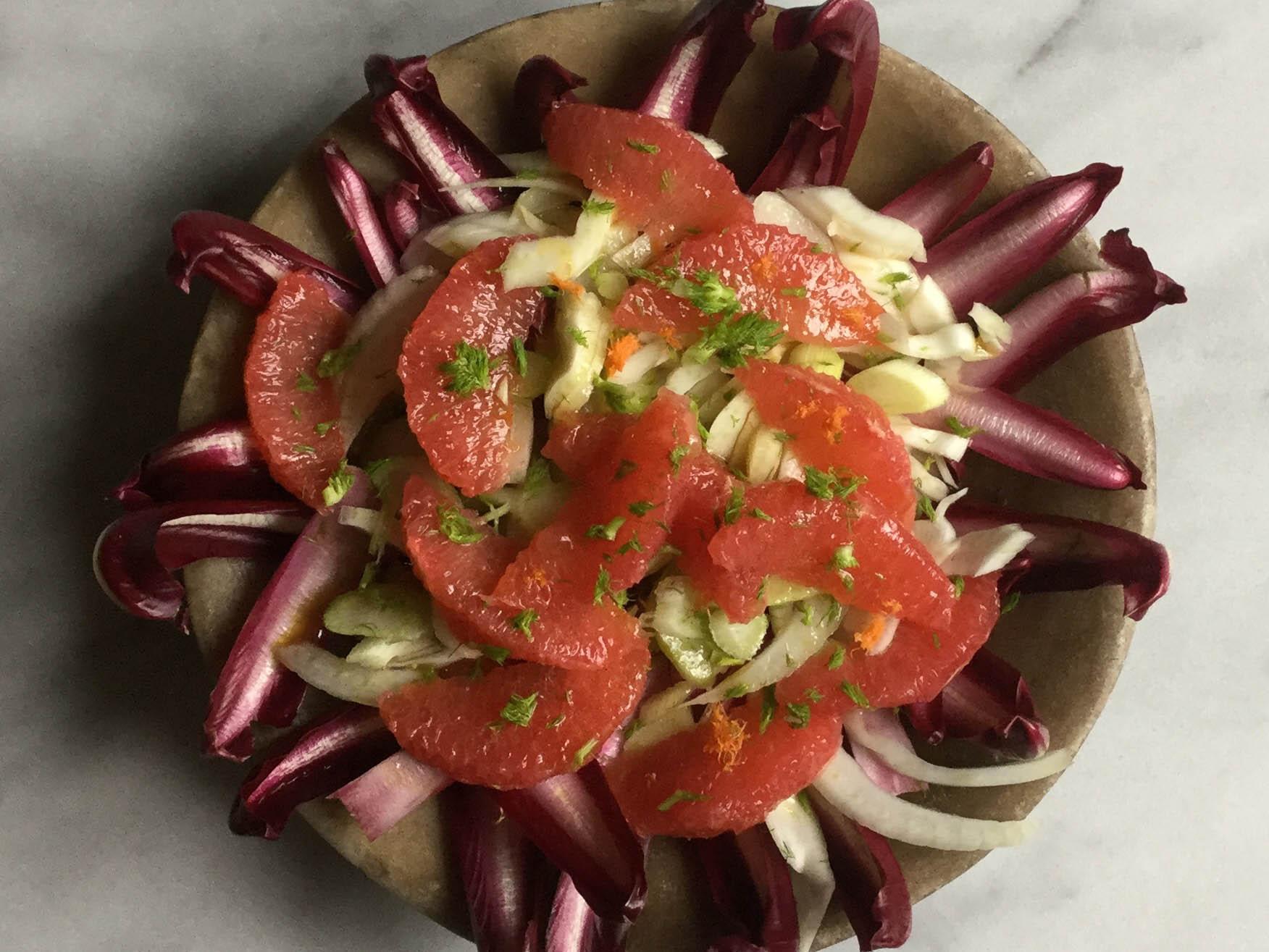
Bright and bitter, this salad uses crisp fennel and tangy grapefruit for a simple, refreshing side. While raw veg is nutritious, it can be harder to digest close to the race.
Marathon-friendly adjustment: Steam the fennel lightly to lower fibre and pair with a starchy side like couscous, plain rice or a white bread roll for more usable carbs.
Recipe by: Julia Platt Leonard
Serves: 4
1 pink grapefruit
150g radicchio
150g fennel (about half of a large head)
Olive oil
1 tsp honey
Salt and pepper
Micro herbs to garnish (optional)
Method:
- Grate a bit of the lovely reddish-pink skin of the grapefruit and set aside to use later to garnish the salad. Place the grapefruit on the cutting board and take a slice off both ends so it can stand securely on your board. Take your knife and slice away the skin – making a curved cutting motion so that you follow the contours of the fruit. You want to remove all of the skin and pith but leave as much of the flesh intact as possible.
- Now cut out the individual grapefruit segments. Make a v-shaped cut to remove one segment at a time. Do this over a measuring jug so you collect any juice. Place the segments on a plate and set aside. Take the remaining membrane and squeeze it over the jug to release as much juice as possible.
- Check how much juice you have (I get 40-50ml from a juicy grapefruit) and add an equal amount of olive oil and the honey. Stir to combine. Season with salt and pepper. Taste – it should be sharp and sweet, but if it feels too sour, add a bit more olive oil (remember you want this to be zesty). Set the dressing aside.
- Break apart the radicchio leaves, wash and dry them. Place them in your serving bowl or dish. Slice the fennel thinly, making sure you remove the woody core at the base of the bulb first. If there are any fronds, chop those up for garnish.
- Top the radicchio with the fennel, then with the grapefruit segments. Lightly dress with the grapefruit vinaigrette. Garnish with a bit of the grated grapefruit skin, chopped fennel fronds and micro herbs (if using). Serve with the rest of the dressing on the side.
Beetroot recipes
Beetroot is a well-studied natural nitrate source, known to enhance endurance and oxygen delivery by improving nitric oxide availability. It’s best eaten 24-48 hours before the race for peak effect.
Beetroot bucatini
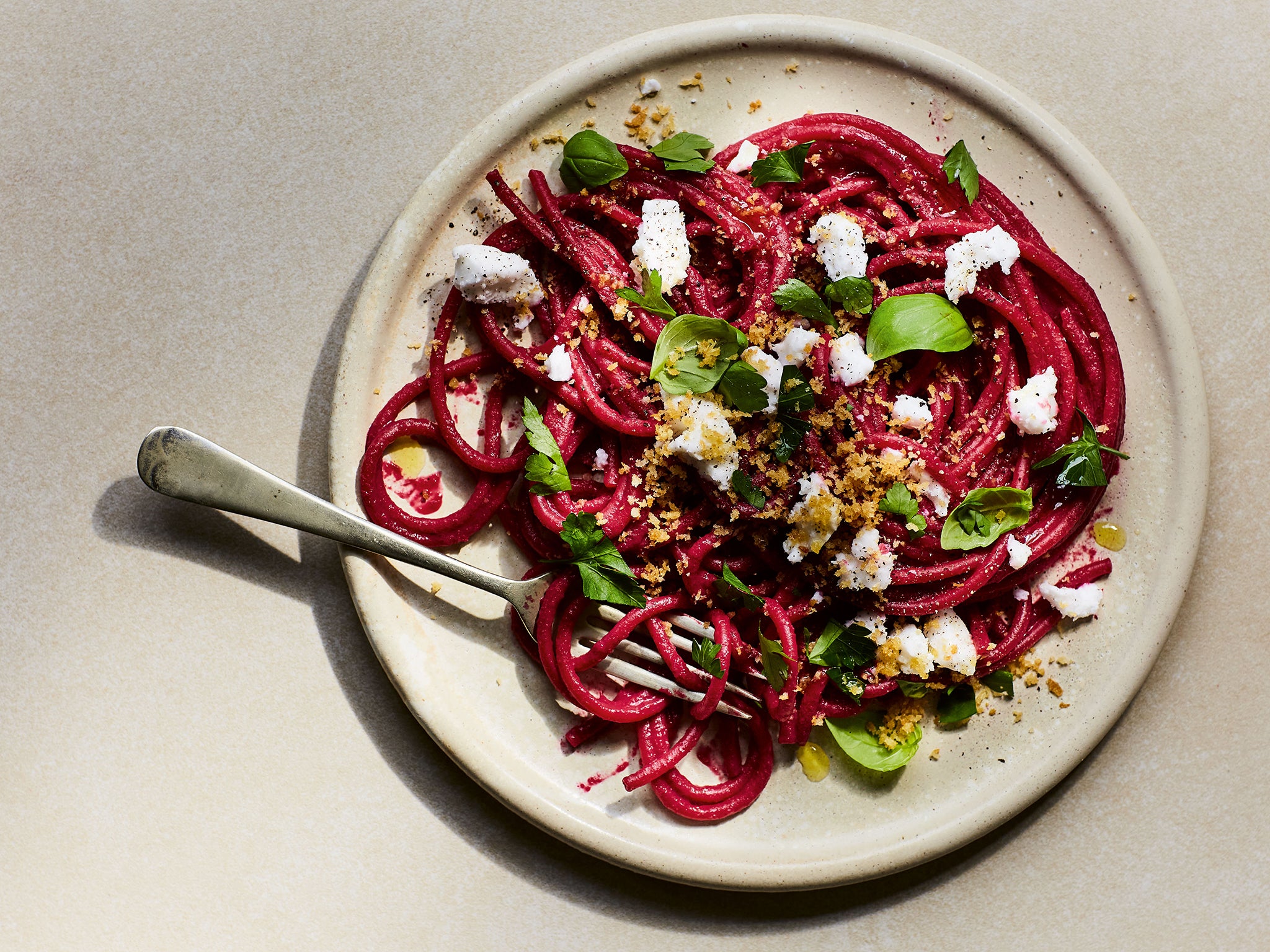
This vibrant pasta dish blends cooked beetroot into a silky sauce and tosses it with bucatini. The pasta provides quick energy, while beetroot brings a subtle performance boost.
Marathon-friendly adjustment: Reduce or omit feta and breadcrumbs. Add a slice of white bread or a banana on the side for additional digestible carbs.
Recipe by: Max La Manna
Serves: 4
Ingredients:
380g bucatini, spaghetti or linguine
40g feta, crumbled, to serve
Beetroot sauce
1 large beetroot, including the stems and leaves
1 tbsp olive oil
1 onion, chopped
2 garlic cloves, finely chopped or crushed
1 tbsp chopped parsley stems
1 tbsp chopped fresh basil stems, plus basil leaves to garnish
4 tbsp nutritional yeast
Juice of ½ lemon
1 tsp salt
½ tsp black pepper
70ml oat milk
For the crispy garlic breadcrumbs:
1 tbsp olive oil
1 garlic clove, grated or thinly sliced
50g breadcrumbs (homemade from a stale loaf, or shop-bought)
Method:
- To make the beetroot sauce: bring a pan of water to the boil, add the whole beetroot and cook for 10-15 minutes or until tender. Drain the beetroot and set aside to cool for a few minutes, then cut into quarters.
- Meanwhile, in a non-stick frying pan over medium heat, heat the olive oil and cook the onion, garlic, parsley and basil stems for 3-5 minutes until fragrant and soft. Remove from the heat; do not wash the pan.
- Put the beetroot into a food processor or blender, add the onion mixture, nutritional yeast, lemon juice, salt and pepper. Pulse for 1 minute, then, with the motor running, stream in the milk. Blend on high speed until very smooth. If the sauce is too thick, add a little more milk, 1 tbsp at a time, to loosen.
- Bring a large pan of salted water to the boil, add the bucatini and cook for 9 minutes or until al dente. Drain the pasta, reserving 4-5 tbsps of the pasta cooking water.
- Meanwhile, prepare the crispy garlic breadcrumbs. In a separate frying pan, heat the oil over medium heat, add the garlic and fry for 1 minute until lightly browned. Add the breadcrumbs and cook, stirring frequently, until the breadcrumbs are lightly charred and fragrant, about 2-3 minutes. Remove from the heat and set aside.
- In the same frying pan used for the onion and garlic, add the cooked pasta and beetroot sauce and stir well over low-medium heat for 2 minutes. If too thick, stir in some of the reserved pasta water.
- Serve the pasta in bowls or on plates, garnished with roughly torn basil leaves, crumbled feta cheese and crispy garlic breadcrumbs.
Tips: Use gluten-free pasta and breadcrumbs if you prefer. Store any leftover pasta and garlic breadcrumbs separately.
Beetroot hummus
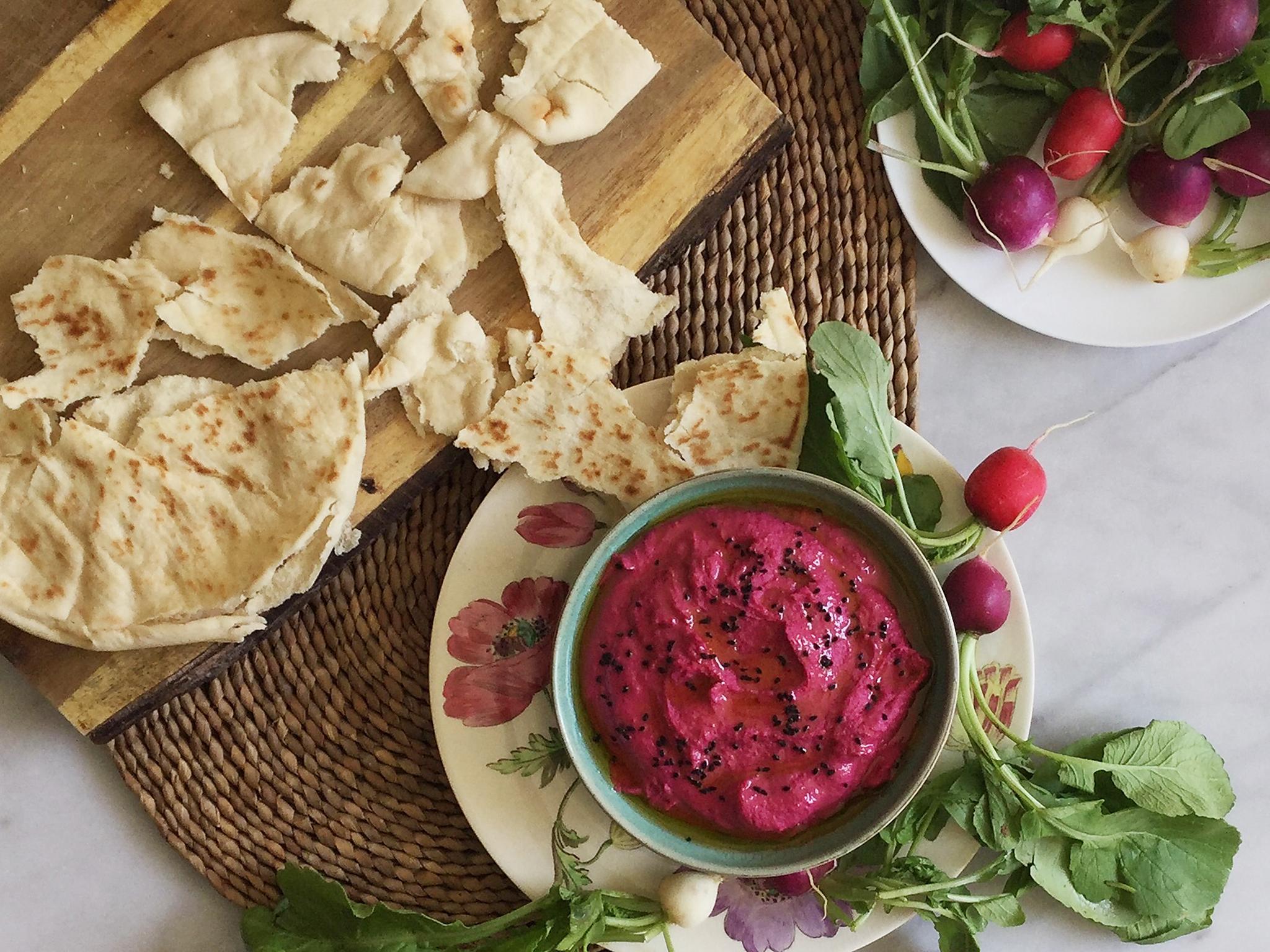
A bright dip made with chickpeas, beetroot and tahini. Chickpeas are fibre-rich, so this is best used in small amounts as a snack.
Marathon-friendly adjustment: Serve with low-fibre options like white pitta, toast or crackers. Keep chickpea content modest and avoid serving with raw veg crudités.
Recipe by: Julia Platt Leonard
Ingredients:
1 tin of chickpeas (240g), drained and liquid reserved
1 clove garlic, roughly chopped
1 lemon, juiced
2 tbsp tahini
50g cooked beetroot (about one small-medium beetroot), chopped roughly
1 tbsp olive oil plus additional for drizzling
Salt
Nigella seeds to garnish (optional)
Method:
- Blend the chickpeas, garlic clove and lemon juice with a stick blender or in the small bowl of a food processor until smooth. Add the beetroot, tahini, a tbsp of the liquid reserved from the chickpeas, and a tbsp of olive oil.
- Blend again. You want a smooth, creamy texture: if too thick, add another dash of the chickpea liquid. Taste and season with salt. Place in a bowl, garnish with the nigella seeds (if using) and a healthy drizzle of olive oil. Serve with crudités, pitta bread or flatbread.
For more detailed guidance on what to eat and when, visit the official London Marathon nutrition page.
Join our commenting forum
Join thought-provoking conversations, follow other Independent readers and see their replies
Comments